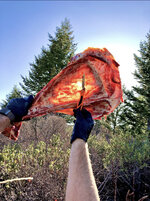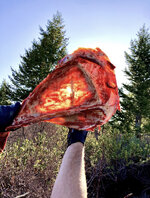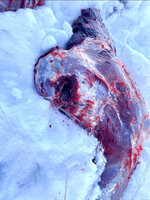Questions-
Are the elk you have witnessed recently been primarily cows or bulls? General region of the country?
Both. ID, MT, WY.
The bull versus cow thing is another that belief that most have, that has not shown to be the case at all. Bulls have not been any harder to kill, or moved farther after hits, or took more hits than cows. Actually the opposite. The cows on average have moved farther and taken more shots before falling than the bulls. This is most likely due to the cows being in large herds and trying to stay with the herd.
Were there any quartering shots on big bulls taken where the bullet had to either pass through the paunch to reach the vitals or go through the point of the shoulder? If so, what were your observations?
Lots. The 223, 6mm, and 6.5 threads are filled with pictures from me of broken “shoulders”. The shoulder thing is another oft mentioned “issue” that has no bearing in reality. The scapula is as thin as standard cardboard; you can see your hand through it held up to the sky and a Havalon blade can be stabbed through it without breaking. How do people believe that a piece of brittle cardboard is going to stop a bullet?
This is the “shoulder” of a bull moose. It is far larger than any elk scapula.


That moose was killed with a 223/77gr TMK. The only part that is thicker than cardboard is the scapula ridge, and that ok, it went through that and both lungs just fine-

As for going through the guts on a quartering away shot- no. There are no bullets that can guarantee not getting caught in a full stomach and then failing to penetrate to the chest cavity. I’ve caught 30cal and 338 bonded and mono bullets in deer getting caught by a stomach full of grass. If I were to take a shot where the bullet can’t be put into the lungs first- I put it in the back of the neck, or shoot the pelvis/hips at the spine breaking the animal down knowing that an immediate follow-up shot will be required.
This is an follow-up shot when the elk turned after the first hit-

402 yards, raking, that is the exit after going through stomach and the femur. There is nothing in the front half of an animal that harder on bullets than a femur. It also is from a 223 and 77gr TMK.
What was your motivation for using and encouraging these small calibers on elk?
The only thing I am encouraging is for people to shoot more. What I’m trying to do is provide information that isn’t based in fallacies, myths, or dogma. Due to several reasons I have killed and seen a lot (
a lot) of game killed- in the thousands.
Due to an education in terminal ballistics and a data driven thought process I tracked what happens when those animals were shot. I was brought up where a 7mm Rem Mag was at the low end of acceptable for deer, and really a good deer rifle was a 300 win mag or better. Except for two with a 30-06, the first 120-130 deer I killed were with a 300 win mag or a 300 RUM. Then others started hunting too, and I killed and watched a lot die to 308’s, 243’s, etc.
What became evident very quickly when shooting that many animals was that bullets mattered, caliber didn’t, and poor shots almost never happened with the 243.
When I went back and compiled the results of the first 100 animals with the 243/95gr NBT combo against last 100 animals with the 300WM using the most destructive bullet available, the 243 had no guts shots or wounds, and only 4 deer out of those 100 moved after the hit. It “killed” better than the 300 wm.
Moving a few years forward people were asking why I didn’t hunt with an AR15- my response was because “223 is marginal”. To which I got challenged on because we knew exactly what 223 with good bullets did to 200lb mammals. So, I shot a deer with a 62gr Gold Dot. It died suddenly. So I did it again. And again it died suddenly. This continued with bonded and mono 223’s, NBT’s, V-max’s, and some with HPBT match bullets for a few years. Then, the 77gr TMK was developed- and that changed the whole show. The Gold Dot and Fusions, etc are good bullet and they kill well, however the 77gr TMK is 223 maximized.
Long story, not as long- what has been seen across the board is that everyone regardless of skill level- from world class shooters and extremely experienced hunters, to brand new shooters and first animal, everyone- shoots less recoil and muzzle blast better.
The 223/77gr TMK combo has the highest success rate out to 450’ish yards of any cartridge and bullet combination my group has seen.
We’re averaging 1 out of 100 animals with the 223/77gr TMK combo that is anything other than decisive. That’s on antelope, multiple deer species, bear, elk, and moose from muzzle contact to 803 yards (I’m not recommending anyone with anything shoot 800 yards), and non of those are waiting for “perfect” shot presentations. What is consistently seen from a huge variation in hunters/shooters with recoil above 20ft-lbs (magnums) is 2-3 out of every 10 animals are problems- whether that’s missing or wounding.
On demand success on animals is why I and others use “small” cartridges. I’m not a “fan” of anything except success. 223/6mm/6.5/whatever are not my “favorite”. I get to see quite a few people each year hunt and kill animals and the factors that show to have the largest effect are in order- on demand field shooting ability, rifle system that stays zeroed and works correctly, emotional control, and projectile design. Caliber has shown zero effect on “killing”. When we go hunting I want the animal to die as quickly as possible with the least amount of fuss. In hundreds of animals with them; 22cal, 6mm, and 6.5 does that with the least issues.




